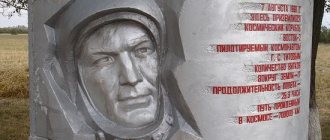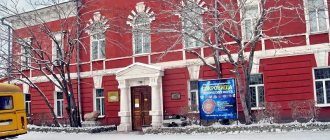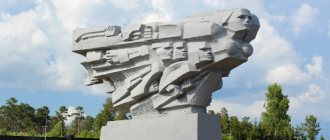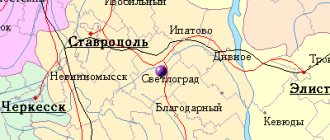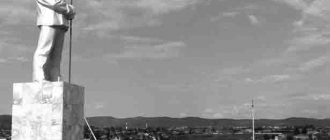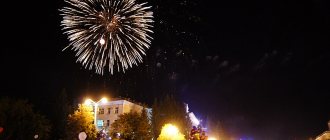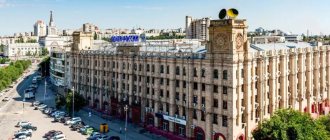(Historical essay) Section: History of Russia Author: Drovaleva Anastasia Yurevna
I was born and live in the most beautiful region of Russia, Krasnodar! In the small town of Apsheronsk. I am a student at the State Budgetary Educational Institution of Secondary Vocational Education “Apsheron Forestry Technical School”. My future profession is a forest regeneration technician. I am passionate about the history of my country and directly the history of my hometown. My city is a regional center with a population of about 40 thousand people. Apsheronsk is located in the southern part of the Krasnodar Territory on the northeastern slopes of the spurs of the Greater Caucasus. The current Apsheronsk is one of the most impressive and picturesque corners of the Krasnodar region. It is considered a promising center for the development of health centers and tourism.
But I want to dwell on the period of the founding of my hometown, when no one could have imagined that there would be a unique area for recreation and recreation, where tourists would come to admire the beauty of our places. I want to talk about an important stage in the history of my hometown from 1863 to 1900, when every piece of land had to be fought for, showing courage and bravery. Not many people know about the history of my hometown, but it has a legendary past that is inextricably linked with Empress Catherine II. At her behest, the Absheronsky regiment of brave Cossacks was organized to defend the southern borders of Russia from the Turkish invasion. These brave warriors not only knew how to conduct combat operations, but were also distinguished by their ability to build.
In January 1863, having completed the construction of the Pshekhinskaya village, the regiment moved further up the Pshekha River. “Having walked 15 versts,” writes the regiment’s historian, “the troops stopped at the confluence of the Tukha River with Pshekha, where it was decided to build a new village and name it in honor of our brave regiment - Absheronskaya.” Many of the detachment liked our places, they moved their families and began to develop the nearby territories. This is how my hometown was founded.
Soon after the founding of the Absheronskaya village, more and more families of immigrants began to arrive there, mainly from the provinces of Ukraine. The oldest settlers of that stage are considered to be the following families: Barabash, Galkin, Goncharov, Gritsenko, Denisenko, Doroshenko, Zarevchatsky, Ilyashenko, Knyazev, Levchenko, Morgunov, Morozov, Motsarev, Ovcharenko, Otryaskin, Plotnikov, Rybalkin, Suprun, Tarasov, Tur, Tsurevsky, Chaikins, Chernyshevs, Shalaevs.
Behind one hut another was built, a church was built, and the first government appeared. A little later, a parish school was opened at the Orthodox Church for local children, who became more and more numerous every year. Before the construction of the school building, the first teacher of the Absheronskaya village, the Cossack constable Eremenko, went directly to the huts and taught the Cossacks to read and write. In 1871, a two-class six-year school was opened in the village (in each class, Cossacks studied for 3 years)... This is how education was organized and the beginning of education was laid in our city of Apsheronsk.
“While the villages were being built and settled, columns of Cossack fighters went on raids to enemy villages and destroyed them,” testifies V.N. Ratushnyak, an expert on the history of Kuban.
Of the ten villages newly built and settled within our Absheronsk region: Pshekhskaya, Kubanskaya, Apsheronskaya, Shirvanskaya, Samurskaya, Bzhedukhovskaya, Kurinskaya, Dagestanskaya, Nizhny Novgorod and Gabukaevskaya (now Ryazanskaya), - by order of the commander of the Caucasian Army in 1863, 26 th cavalry regiment of the Kuban Cossack army with headquarters in the village of Apsheronskaya and was also named Apsheronsky, now after the location of the headquarters. And that Apsheronsky regiment, which founded the Absheronskaya village and gave it its name, continued campaigns to conquer the Caucasus for more than a year, until the end of the Caucasian War in general. For skillful actions and courage shown in the battles for the conquest of the Western Caucasus, the Cossacks of the Absheron regiment were awarded the Horns of St. George. The regiment existed for more than two hundred years, until the formation of the tsarist army ceased.
Many historical books have been written about the Absheron Regiment. In 1896, “Chronicle of the Caucasian Wars” by A.T. was published in Tiflis. Ghisetti.
Captain of the Absheron Regiment L.A. In 1892, Boguslavsky published the “History of the Absheron Regiment” in three volumes, in 1894 the “Absheron Regiment” was created, which contained a brief history of the Absheron Regiment for the soldiers of this regiment, and in 1900 the book “Absheron Regiment 1700 - 1900” was published. In memory of the 200th anniversary of the native regiment." These books, published in St. Petersburg and Moscow, are now stored in the Russian State Library. IN AND. Lenin in Moscow and other Russian libraries.
From sources we learn that Lieutenant Colonel Pistolkors was appointed the first commander of the Absheron Cossack Regiment No. 26 on the basis of the already named newly founded villages. A monument to this heroic man stands in the center of Apsheronsk.
Lieutenant Colonel Pistolkors led the Absheron regiment for a short time - until September 30, 1864, but left a good memory of himself with numerous good deeds for the Cossacks and the local population. He maintained “iron” discipline, and for more than a year of his “reign” not a single Cossack of the regiment was put on trial or subjected to corporal punishment or fines.
The Cossacks, protecting the population, often repelled the raids of the highlanders. In the village of Apsheronskaya, guard gates were built: at Pshekha (where the Maikop Bridge was built later, in 1888) and at the Tukha River. There were also cannons at the guard posts. Around the village on the hills there were watchtowers, on which Cossacks were on duty around the clock, lighting fires in the event of the approach of the highlanders.
In the very first autumn, in 1863, the first schools for teaching children to read and write were opened in the newly built and populated villages. We must pay tribute to the regiment commander A.V. Pistolkors, who understood the need for education and did everything possible to ensure that at least primitive schools were opened. In an order dated October 11, 1863, he wrote, addressing the heads of the villages: “... With the cessation of household work and the beginning of winter, all young children of the Cossacks remain in complete inactivity, meanwhile, the need for education is strongly felt in the Cossack class, and, in the present progressive time, not a single illiterate Cossack can be promoted not only to officers, but even to non-commissioned officers...”
The main sources of livelihood for the population in the first years after the settlement of the Absheronskaya village were the procurement of wild fruits (pears, apples, nuts, dogwood), hunting and fishing. All this gave good income, but after two decades hunting and fishing became a source of entertainment, since the predatory extermination of fish and animals led to their destruction. And by 1900, individual Cossacks began to engage in pottery, cooperage and blacksmithing. During these same years, Greeks and non-Greeks began to grow tobacco.
By this time, a mortar plant, a mill, an oil mill were being built in Apsheronsk, and a number of artisanal artels appeared. But the impetus for the development of industry was the opening of oil fields. In 1865, wells were founded between the villages of Apsheronskaya and Neftyanaya (oil was discovered here in the 10th century).
In 1878, a primitive oil refinery was built, the first oil mills were opened, vast areas were sown with oats and rye... Later, the village of Apsheronskaya was renamed into a city, and then a regional center was formed...
My city is the regional center to this day. There are 260 food and wood processing enterprises on its territory. The region pays great attention to healthcare and education. There are 37 schools here, including a lyceum and a gymnasium, 40 preschool institutions, secondary vocational education institutions and NGOs. And all these enterprises employ the descendants of the first settlers of the Absheronskaya village. Their names are familiar to every resident.
In conclusion, I want to say once again that every person has his own homeland, for one it is his home, for another it is his hometown, and for some it is an entire country. And I am proud to live in the Absheronsky district - the most beautiful and wonderful corner of the vast country of Russia!!!
Sources:
1. B.A. Three brothers. History of Kuban from ancient times to the end of the 18th century. Krasnodar, 2000.
2. V.N. Ratushnyak. History of Kuban from ancient times to the end of the 19th century. Krasnodar, 2000.
3. Kubanoved website https://www.kubanoved.kubannet.ru/
4. Website Caucasian Nature Reserve https://kgpbz.ru/
5. Website of the south of Russia https://www.yuga.ru/
Section: History of Russia Date of publication: 01/14/2014 20:05:14
1
Subscribe to our telegram channel Join our group on VKontakte
Other social networks:
Share material on social networks: You may be interested in other materials from this section:
Russian Empire in World War I
The immediate cause of the war was the assassination of the heir to the Austro-Hungarian throne, Franz Ferdinand, on June 28, 1914 in the city of Sarajevo by a Serbian nationalist. Austria-Hungary presented an ultimatum to Serbia, enlisting the support of Germany. In response to Serbia's refusal to accept the ultimatum, Austria-Hungary declared war on it. Germany also declared war on Serbia after its ally. Russia could not remain aloof from what happened and, under pressure from its public, declared war on Germany and Austria-Hungary. The Entente countries also declared war on Germany and its ally. .
Read
Accommodation in Apsheronsk – hotels and hotels
Motel on Voroshilova is located close to the center. Its rooms look rustic, but the hotel is in demand, tourists leave positive reviews, highlighting the cleanliness and comfort of all rooms. A good location will allow you to use the necessary infrastructure of the city without effort. Nearby guests will find cafes and chain stores. For travelers traveling by private car, parking is provided free of charge. But it is recommended to book rooms in advance.
In Apsheronsk, special attention is paid to the Svetly dispensary. Within the walls of this attractive building, guests will find spacious rooms of various comfort classes. Opposite the base you will find a river, on the banks of which you can simply relax, organize a picnic or go fishing.
The Niagara Hotel offers a wide range of apartments available for booking. The central location ensures accessibility to civilization. Within walking distance are cafeterias, grocery stores, shopping shops, etc. At the hotel, guests can take advantage of a number of additional services: laundry, beauty salon, mini-market and souvenir stall.
You can also stay at the attractive Grant Hotel. The number of rooms is bright, beautiful rooms, which are decorated with exquisite textiles. Guests note that it is quiet and clean. There is free but unguarded parking right in front of the building.
Visitors can rent a nice apartment in the Guest House on Yudina Street. They note the interesting interior of the entire mini-hotel and proximity to infrastructure. It won't be difficult to find a shop or bar in the area.
Historical sources about Princess Sofya Alekseevna
The four hundredth anniversary of the House of Romanov is one of the most high-profile historical memorials celebrated in 2013 in our country. Representatives of the reigning dynasty have always aroused increased interest both among society as a whole and among individual figures in historical science, fine and musical arts. A modern person has many opportunities to get acquainted with their works and enrich their knowledge about a particular ruler. But, unfortunately, not all Romanovs were lucky enough to be assessed impartially and at their true worth. .
Read
Apsheronsk sights and entertainment
In addition to clean air, Apsheronsk offers holidaymakers a number of reminders and entertainment.
History fans should definitely visit the Absheronsk Museum of History and Local Lore. It appeared relatively recently, in the 1960s. In 2000, the exhibits were placed in a separate building, which is now ready to receive visitors. Several exhibition halls tell the story of the life of the Cossacks, the events of the Great Patriotic War and the life of the peoples of Kuban. The exhibited materials reflect the spirit of the area, its history and culture.
The Komarovo Club tourist center should be considered not only as an accommodation facility, but also as one of the attractions of Apsheronsk. And all because there is a swimming pool with water from thermal springs on the territory. Mineral water has healing and restorative properties. Bathing is available all year round. It’s also easy to relax in the herbal rejuvenation vat. The procedure improves blood circulation, metabolism and promotes renewal and restoration of the body as a whole. Fans of active recreation will enjoy the paintball zone and horseback riding. Fishing and hunting will make the stay of the male part of the base population as eventful and productive as possible.
While walking around Apsheronsk, it is worth paying attention to the city park “Yunost”. Here you will have fun, enjoy nature, ride bicycles, roller skates, skateboards, and try various attractions. On the territory there are ponds, gazebos and lavas, a lot of greenery and trees. Here is a monument to the Cossacks of the village of Apsheronskaya. The site is also a mass grave for those who fell into the hands of the punitive squad in the 20s. last century. The arrest was made solely on the basis of establishing membership in the Cossack brotherhood. There is another attraction in the park - a memorial sign topped with an eagle, telling the story of the founding date of the city.
Here you will also find the Eternal Flame Memorial, which was installed a quarter of a century after the victory in the Second World War. The mass grave located here became the final refuge for more than two thousand soldiers who fought for their native land.
What else to see?
A ride in a trailer along the Absheron narrow-gauge road helps you get a lot of impressions at once, take memorable photos and get acquainted with the various riches of the surrounding area. This route will introduce you to an incredibly beautiful corner - the Guam Gorge. This trip will not leave indifferent fans of lush natural vegetation and adrenaline. Indeed, this is an interesting experience.
In Apsheronsk itself, a Monument to UZK railway workers was erected, there are a number of religious sites, among them the Monastery in honor of the icon of the Mother of God “The Unbreakable Wall”, the sky-blue Nativity of St. Nicholas Church, the Armenian Church of St. George, reminiscent of an ancient castle, and also the Holy Intercession Church temple and church of Tikhon, Patriarch of All Russia, etc.
The surrounding area offers endless opportunities for lovers of active pastime and unity with Mother Nature.
Where to eat
You can have a quick snack or take coffee with you at Yesh fast food. It’s easy to order food delivery here. “Mimino” attracts with its interior, because it is dominated by the theme of the film of the same name - this gives the establishment a special flavor. “Sicily” has delicious cuisine and a functional interior - the room is bright, and a number of tables have barriers that allow for privacy. Visitors to the U Egor tavern leave positive reviews about the cuisine and service.
The very spacious Astoria cafe is perfect for hosting a banquet. Here you will be offered a simply delicious meal, without being tied to a special event, and have a great time in a cozy atmosphere. As you can see, it is not difficult for travelers to find a place where they can have a delicious and extremely satisfying meal. Apsheronsk has a wide selection of cafes and restaurants. Everyone will be able to choose an establishment to suit their taste and budget, meeting the maximum number of requirements.
How to get there (get there)?
Getting to Apsheronsk is not difficult - it is connected by transport links to neighboring regional centers and Krasnodar. In addition, buses passing through the city go to Sochi and other resorts in the Krasnodar Territory, as well as to Astrakhan.
By car from Krasnodar you can independently get to Apsheronsk like this:
The city of Apsheronsk is surrounded by wonderful natural beauty and delights guests with good infrastructure. A vacation here will allow you to enjoy the Krasnodar region to the fullest, move away from noisy, polluted megacities, restore energy, and gain new knowledge and impressions. In conclusion, watch the video about Apsheronsk, enjoy watching!
Class hour "History of the city of Apsheronsk"
History of the formation of the city of Apsheronsk
Apsheronsk
- a city in Russia, the administrative center of the Apsheronsky district of the Krasnodar Territory. Population 40.0 thousand inhabitants (2008). The city is located on the northern slope of the Main Caucasus Range, on the Pshekha River (Kuban basin, left tributary of the Belaya River), 103 km southeast of Krasnodar, 43 km from Belorechensk, 5 km from the border with Adygea.
This year our city turns 150 years old
.
The city was founded in 1863 as a village at the camp of the Absheron regiment
of the Russian army.
History of the Absheron Regiment.
The history of the city of Apsheronsk is connected with the history of the conquest of the Caucasus in general, and its name goes back to the distant past of military campaigns of the oldest regiment of the Russian army - Apsheronsky, which originated from a company in 1700 and was formed as a regiment during the Persian campaigns of Russian troops under Peter. The regiment was named after the place where it was stationed on the Absheron Peninsula (Azerbaijan) during the Persian campaign of Peter I
in 1722 - 1723
Generally speaking, many settlements in the region received their names from the regiments stationed here in the 60s and 70s of the 19th century. There is even a legend that in one night in the 60s of the 19th century, several regiments were massacred by mountaineers. The Absheron regiment
covered its banner with many valiant battles, in particular, it participated in: the siege of the Azov fortress (1736), campaigns in the Crimea (1738 - 1739), a business trip to Sweden (1743), the capture of the Izmail fortress (1791), the Battle of Berezina (1812) ), capture of Paris (1814), storming of the village of Gunib (1859).
In 1862, the regiment set up camp at the confluence of the Tukha and Pshekha
, that is, in the area of the military registration and enlistment office.
The goal was to force the village of Khadyzhi to peace, which was done in 1863. The first villages were: Pshekhskaya, Kubanskaya, Apsheronskaya, Shirvanskaya, Samurskaya
.
The names of the villages, including Absheronskaya, were approved by Emperor Alexander II on September 3, 1863. On the basis of these villages, the 26th cavalry regiment of the 4th brigade of the Linear Cossack Army was formed; this regiment also included the villages of Kurdzhipskaya, Dagestanskaya, Nizhny Novgorod, Bzhedukhovskaya, Tverskaya, Prusskaya (Bezvodnaya)
. The regiment's headquarters was located in the station. Apsheronskaya.
The arrangement of the village was carried out by the commander of the 26th regiment, Lieutenant Colonel A.V.
Pistolkors.
Life of the Cossacks
The first settlers of the village were Seleznev, Nosov, Cherkashin, Nozdrin, Chepurin. Semyon Fedorovich Seleznev was one of the first to build housing.
Since January 1871, the village began to be governed by an elected ataman. This form of government lasted 35 years. During this time, two hub factories, three mills, an oil mill and a brick factory were built. A military hospital with 25 beds was built. The first school, a two-year six-year school, was opened in 1871, and a parochial school was opened in 1890. The first house was located on the site of the modern Gorbushka market; it was an adobe house that existed until the mid-90s.
The Cossack was in the service all his life. He was prepared for this from childhood, teaching him horse riding and the ability to wield a saber, a dagger, and at the same time marksmanship. From the age of 21, a Cossack went into service and served for four years. The Cossacks “managed” their combat horses, ammunition and bladed weapons themselves. After compulsory service in the Russian army, a Cossack until the age of 48 was registered with the military in his village, obeyed his ataman, kept a combat horse, and 3-4 times a year participated in training maneuvers and training camps with trips to field camps.
For service to the Fatherland, a Cossack was entitled to a land allotment, and there was a lot of land, and each born Cossack girl was entitled to a separate land share. The life of the Cossacks was difficult, but more prosperous than that of the peasants of central Russia. The Absheron Cossacks reached their greatest prosperity, as in the whole country, by 1913.
Civil War
The civil war did not spare the Absheronskaya village. At the end of September 1920, 118 Cossacks were killed in the village. At the site of the death of the Cossacks, a six-meter-high Poklonny Cross was erected, near which memorial services are held in memory of the fallen. By the thirties of the twentieth century, the Absheronskaya village had entered the rut of peaceful life. It was during these years that a railway was built into the village, a dairy plant began operating in 1932, and a fruit farm in 1940. The peaceful life of the village, like the entire country, was interrupted by the Second World War.
The Great Patriotic War in the Absheron region
The war in the region lasted from August 14, 1942 to January 27, 1943. This was the Tuapse defensive operation. Mount Opelepen
(height 1010, on maps indicated as height 1006) is a mass grave of many of our compatriots. At the top of the mountain, German soldiers of the Edelweiss group dug in, and Soviet troops took the heights, dropping troops and attacking from the foot of the mountain. Anyone who was there will understand that it was suicide. As a result, we gained altitude. At the top, on the side of the rock, there is a cave; there was a German headquarters there. Why was this height needed? This is an excellent observation point and commanding height over a large section of the Pshekha River valley.
There were also fierce battles for the heights: Bezymyannaya, Tochichnaya, Sarai-mountain, Batareynaya, Semashkho, Outl, Gunai. There is a legend about the Wolf Gate
— they were held for a week by one machine-gun crew of the Red Army.
The partisan movement was developed in the area
- nature favors this. Detachments of V.Z. Stakanova, named after Shchors and others.
The Absheron land raised 7 heroes of the Soviet Union (Volosevich, Gusev, Lyakh, Mishchenko, Slavyansky, Kashcheeva). Suvorov and Novitsky received this title while defending our region.
About 5,000 Soviet soldiers and city residents were buried in the area of the Eternal Flame of Apsheronsk.
Eternal Flame in Apsheronsk
Life after the war
The joy of the victory of the Soviet Union in the Great Patriotic War, the labor enthusiasm that swept the entire country in the second half of the 40s, naturally did not pass by the Absheronians. October 23, 1947
Absheronskaya village received
city
.
An auto repair plant was created, a lumber mill started operating in 1946, a tractor plant started operating in 1953), a timber plant started operating in 1955, and the wood processing plant PDO "Apsheronsk" began operating in 1959. The city is surrounded on almost all sides by dense deciduous forests, including oak, beech, maple, aspen, hornbeam, etc. Such natural resources determined the main direction of the economy of Apsheronsk - logging and wood processing. Tourism
Currently, a new branch of the economy is developing in the region - tourism. The city of Apsheronsk is located in picturesque places. Thanks to the development of the timber industry, Apsheronsk also owes its main attraction - the only narrow-gauge mountain railway in Russia has been preserved here to this day, and most importantly, continues to function.
Recently, the unique railway has been attracting more and more tourists, and this is quite natural - the trip will be remembered for a lifetime! From the city, through majestic forests, along mountain rivers, past steep mountain slopes overgrown with moss and boxwood, an almost toy diesel locomotive slowly pulls a couple of almost toy passenger trailers. And the journey from Guamka to Mezmay will completely captivate your heart - this short section passes through the Guam Gorge - one of the most beautiful places here, where the road passes through a terrace carved into the rock. Welcome to the city of Apsheronsk! Any resident of this city will proudly say: “Apsheronsk is my city, my dearest and most beloved! »
.

